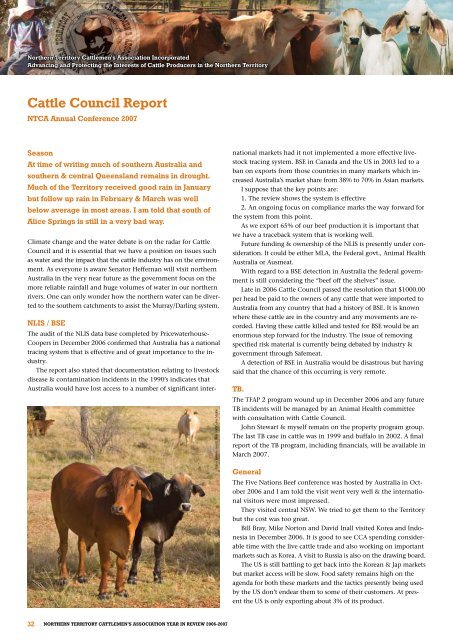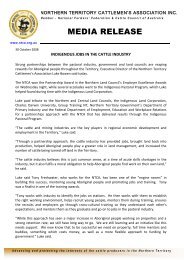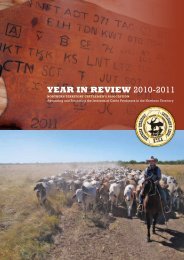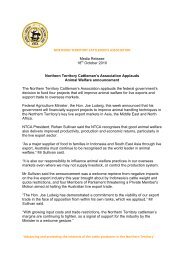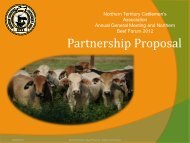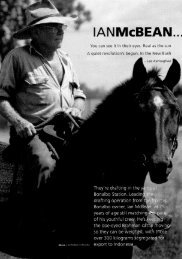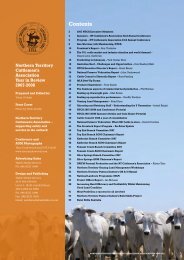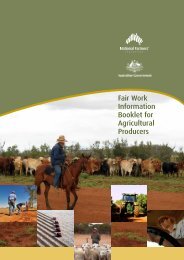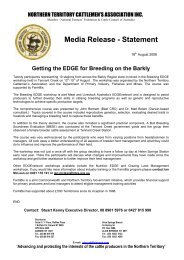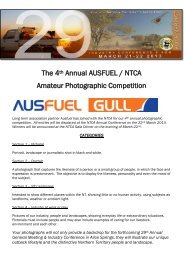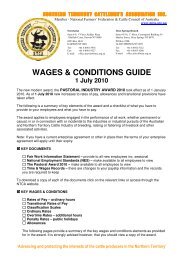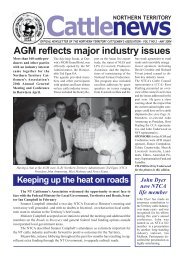2007 NTCA Yearbook - Northern Territory Cattlemen's Association
2007 NTCA Yearbook - Northern Territory Cattlemen's Association
2007 NTCA Yearbook - Northern Territory Cattlemen's Association
You also want an ePaper? Increase the reach of your titles
YUMPU automatically turns print PDFs into web optimized ePapers that Google loves.
<strong>Northern</strong> <strong>Territory</strong> Cattlemen’s <strong>Association</strong> Incorporated<br />
Advancing and Protecting the Interests of Cattle Producers in the <strong>Northern</strong> <strong>Territory</strong><br />
Cattle Council Report<br />
<strong>NTCA</strong> Annual Conference <strong>2007</strong><br />
Season<br />
At time of writing much of southern Australia and<br />
southern & central Queensland remains in drought.<br />
Much of the <strong>Territory</strong> received good rain in January<br />
but follow up rain in February & March was well<br />
below average in most areas. I am told that south of<br />
Alice Springs is still in a very bad way.<br />
Climate change and the water debate is on the radar for Cattle<br />
Council and it is essential that we have a position on issues such<br />
as water and the impact that the cattle industry has on the environment.<br />
As everyone is aware Senator Heffernan will visit northern<br />
Australia in the very near future as the government focus on the<br />
more reliable rainfall and huge volumes of water in our northern<br />
rivers. One can only wonder how the northern water can be diverted<br />
to the southern catchments to assist the Murray/Darling system.<br />
NLIS / BSE<br />
The audit of the NLIS data base completed by Pricewaterhouse-<br />
Coopers in December 2006 confirmed that Australia has a national<br />
tracing system that is effective and of great importance to the industry.<br />
The report also stated that documentation relating to livestock<br />
disease & contamination incidents in the 1990’s indicates that<br />
Australia would have lost access to a number of significant inter-<br />
©istockphoto.com/Linda and Colin McKie<br />
national markets had it not implemented a more effective livestock<br />
tracing system. BSE in Canada and the US in 2003 led to a<br />
ban on exports from those countries in many markets which increased<br />
Australia’s market share from 38% to 70% in Asian markets.<br />
I suppose that the key points are:<br />
1. The review shows the system is effective<br />
2. An ongoing focus on compliance marks the way forward for<br />
the system from this point.<br />
As we export 65% of our beef production it is important that<br />
we have a traceback system that is working well.<br />
Future funding & ownership of the NLIS is presently under consideration.<br />
It could be either MLA, the Federal govt., Animal Health<br />
Australia or Ausmeat.<br />
With regard to a BSE detection in Australia the federal government<br />
is still considering the “beef off the shelves” issue.<br />
Late in 2006 Cattle Council passed the resolution that $1000.00<br />
per head be paid to the owners of any cattle that were imported to<br />
Australia from any country that had a history of BSE. It is known<br />
where these cattle are in the country and any movements are recorded.<br />
Having these cattle killed and tested for BSE would be an<br />
enormous step forward for the industry. The issue of removing<br />
specified risk material is currently being debated by industry &<br />
government through Safemeat.<br />
A detection of BSE in Australia would be disastrous but having<br />
said that the chance of this occurring is very remote.<br />
TB.<br />
The TFAP 2 program wound up in December 2006 and any future<br />
TB incidents will be managed by an Animal Health committee<br />
with consultation with Cattle Council.<br />
John Stewart & myself remain on the property program group.<br />
The last TB case in cattle was in 1999 and buffalo in 2002. A final<br />
report of the TB program, including financials, will be available in<br />
March <strong>2007</strong>.<br />
General<br />
The Five Nations Beef conference was hosted by Australia in October<br />
2006 and I am told the visit went very well & the international<br />
visitors were most impressed.<br />
They visited central NSW. We tried to get them to the <strong>Territory</strong><br />
but the cost was too great.<br />
Bill Bray, Mike Norton and David Inall visited Korea and Indonesia<br />
in December 2006. It is good to see CCA spending considerable<br />
time with the live cattle trade and also working on important<br />
markets such as Korea. A visit to Russia is also on the drawing board.<br />
The US is still battling to get back into the Korean & Jap markets<br />
but market access will be slow. Food safety remains high on the<br />
agenda for both these markets and the tactics presently being used<br />
by the US don’t endear them to some of their customers. At present<br />
the US is only exporting about 3% of its product.<br />
32<br />
<strong>Northern</strong> <strong>Territory</strong> Cattlemen’s <strong>Association</strong> Year in review 2006-<strong>2007</strong>


